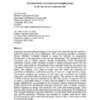Session 7: Preservation and Conservation of Wet Archaeological Materials and Site Management
Dublin Core
Title
Session 7: Preservation and Conservation of Wet Archaeological Materials and Site Management
Subject
Interview with Session 7 chairs Vicki Richards and Jon Carpenter and links to the papers presented in the session.
Description
This session will focus on in-situ preservation and conservation management issues, conservation analyses and treatments, and applied conservation research of archaeological materials from freshwater, marine and wet terrestrial sites. The main purposes of this session are to encourage the exchange of ideas and practices as well as the development of conservation networks throughout the region. Presentations, posters and workshops are invited that address any of the following areas:
• In situ preservation of marine archaeological materials, including reburial practices
• Conservation management of shipwreck sites, including on-site monitoring
• Conservation treatment case studies
• Research into the analysis and treatment of wet archaeological materials
• Review of the status of wet archaeological conservation programs in the Asia Pacific region
• Development of collaborative conservation research and treatment programs Suggestions for additional topics are welcomed by the session organizers.
• In situ preservation of marine archaeological materials, including reburial practices
• Conservation management of shipwreck sites, including on-site monitoring
• Conservation treatment case studies
• Research into the analysis and treatment of wet archaeological materials
• Review of the status of wet archaeological conservation programs in the Asia Pacific region
• Development of collaborative conservation research and treatment programs Suggestions for additional topics are welcomed by the session organizers.
Creator
Vicki Richards and Jon Carpenter
Collection Items
Video interview with Session 7 chair Vicki Richards and Jon Carpenter.
This session will focus on in-situ preservation and conservation management issues, conservation analyses and treatments, and applied conservation research of archaeological materials from freshwater, marine and wet terrestrial sites. The main…
Tracking environmental and historical footprints on Clarence: Comparative XRD analysis of clay-rich sediment samples from a 19th century wreck site in Port Phillip Bay, Victoria, Australia
Little is known about shipbuilding in Australia in the early to mid 19th century. Under the Australian Research Council (ARC) funded Australian Historic Shipwreck Preservation Project (AHSPP) (www.ahspp.org.au), underwater excavations were carried…
Research on the removal of calcareous and iron concretions from marine finds
In recent years, several shipwrecks have been found in the South China Sea, such as Huaguang Jiao I and South China Sea I, shipwrecks from the Southern Song Dynasty (12-13c AD) and Nan’ao I, a wreck from the Ming Dynasty (14-17c AD). Many ancient…
Study of the corrosion of copper coins from the wreck of “The South China Sea No.1â€
The South China Sea No.1 is the wreck of the longest, largest and most preserved shipwreck site in China. It is a classic example of bireme construction and navigational technology. The artefacts located on the site may provide many secrets of the…
The Australian Historic Shipwreck Preservation Project – interim progress report
In early 2012 the Australian Historic Shipwreck Preservation Project (AHSPP) was formally awarded a large Australian Research Council (ARC) Linkage Grant, enabling ten Partner Organisations to join with four Australian Universities in one of the…
The Australian Historic Shipwreck Preservation Project:
In-situ preservation and long-term monitoring of the Clarence (1850) and James Matthews (1841)shipwreck sites
Increasingly archaeologists are opting for on-site examination, reinterment and in-situ preservation of underwater cultural heritage sites as the first option in the management of sites at risk as opposed to the more traditional excavation, recovery,…
Scientific analysis and conservation of porcelain recovered from the Nanhai I in the South China Sea
The Nanhai I is a merchant ship which sank in the South China Sea 800 years ago while transporting different kinds of precious porcelain and metal work. The Nanhai shipwreck is 30 m long wooden vessel lay in 25 m of water and was covered by fine…
The construction of a simple sand dumping barge to aid reburial of a shipwreck site
A gradual and unremitting decrease in the level of the sand forming the seabed in which the wreck of the James Matthews (1841) lies buried (located in Cockburn Sound, Western Australia) became a cause for concern as progressive deterioration of the…
Collection Tree
- Proceedings of the 2014 Asia-Pacific Regional Conference on Underwater Cultural Heritage
- Session 7: Preservation and Conservation of Wet Archaeological Materials and Site Management

